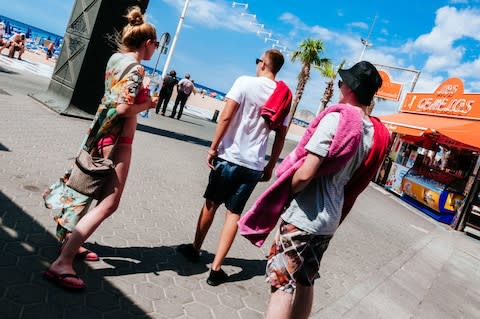Grockle, gringo or guiri? How to tell if you're the worst type of tourist

Despising tourists isn’t new. A French visitor to London in 1552 recorded that “the common people are proud and seditious... these villains hate all sorts of strangers [and] spit in our faces.” Hardly the red carpet treatment.
Those embarking on a ‘Grand Tour’ in the 18th century weren’t exactly welcomed, either – and, given their boorish behaviour, it’s hardly a surprise. “I remembered the rakish deeds of Horace and those other amorous Roman poets, and I thought that one might well allow one’s self a little indulgence in a city where there are prostitutes licensed by the Cardinal Vicar,” wrote James Boswell, the Scottish diarist, upon arriving in the Italian capital. Charles de Brosses, a resident of Rome at the time, lamented: “There are some who will have left the city without having seen anyone but other Englishmen and without even knowing where the Colosseum is.”
“Of all noxious animals, the most noxious is a tourist. And of all tourists the most vulgar, ill-bred, offensive and loathsome is the British tourist,” wrote the clergyman and diarist Francis Kilvert in the 19th century. Don’t mince your words Frank.
Nevertheless, hostility towards tourists has reached new heights in the 21st century. Sightseeing buses in Barcelona have had their tyres slashed, cruise ships arriving in Venice are greeted by angry protestors, and anti-tourist graffiti is becoming commonplace is cities across Europe. “Tourists go home” appears to be a particularly popular refrain; I spotted a slogan smeared on a wall in Lisbon comparing foreign arrivals to a “zombie invasion”.
The sort of visitor angering residents isn’t the one who learns a spattering of the local language, goes out of season and tries to blend in. It’s the one who arrives loudly, with a sense of entitlement, while clutching a selfie stick and trying to tick off all the most famous sights in the fastest time possible.
The Spanish have a word for them: guiri. It applies to foreigners, typically from northern Europe or North America, who stand out like a sore thumb. They eat dinner at 7pm, possibly in a restaurant called “Del Boy’s”, and spend most of their time frying on the beach in socks and sandals.

In Italy, a new term has appeared in recent years: “turisti mordi e fuggi”. It means “bite and run tourists” and, explains Telegraph Travel’s expat expert Lee Marshall, describes those “low-cost day-tripper tourists that contribute nothing to a destination”.
Anthony Peregrine, our France expert, says the Niçois refer to the mass of tourists who descend on their city as “ces cons de touristes” (more or less “these imbecilic tourists”). Once there, they “bronzer idiot” (“get tanned in a brainless fashion”).
Mary Lussiana, Portugal aficionado, says tattooed and/or sunburnt Brits are dubbed the “bife” (“beef”). That’s not a compliment.
“Gringos” are what Mexicans (and other residents of some Latin American countries) might call “consumers, idlers, invaders, or anyone who’s a bit uncool and ignorant,” according to Chris Moss.
On a recent trip to Prague, a Czech resident told me that inconsiderate visitors are usually dismissed simply as “Russians”. Clearly 1968 has not yet been forgotten.
“Farang” is what many Thais called Europeans. It is also what they call the guava fruit; buy one and impress the locals with a joke about a farang eating a farang.
Even Britain, or more precisely the West Country, has its own versions. There’s “grockle”, which Urban Dictionary defines as an “annoying visitor who disrupts the lives of residents”. Another term is “emmet”, which has much the same connotations: a tourist of the worst variety.

Should we be ashamed of being a “guiri”, an “emmet” or a “turisti mordi e fuggi”, and try harder to fit Paul Theroux’s definition of a “traveller” (“tourists don’t know where they’ve been, travellers don’t know where they’re going”)?
Not everyone thinks so. “Self-styled travellers are a terrific pain in the neck,” declares Anthony Peregrine. “Tourists are jollier, more convivial, an absolute economic boon for wherever they gather and, if they are British, share my language. Thus might I talk to them about Preston North End or Nigel Farage over a pint in an Irish bar somewhere. You can’t do that with Laotian goat-herds.
“Tourists are also more honest, admitting to enjoying things that lots of people enjoy – the beaten track is beaten for a reason – and more self-aware. For, in the end, the moment we leave home for pleasure, we’re all tourists – it’s just that the travellers haven’t yet realised it.”
It’s a persuasive argument. But in our modern age of “overtourism” a balance must be found. You needn’t visit Laos or throw away your itinerary, but at least follow a few simple rules:
Consider somewhere else. You want to go to Venice? Try an alternative. You’ll probably get a warmer welcome and you won’t be slapped round the back of the head with some else’s selfie stick
Don’t pack a selfie stick. In fact, don’t take selfies: they are narcissistic. Point your camera at something beautiful that you don’t see every day.
Avoid the “honeypot” sites. Skip the Eiffel Tower and try the Parc des Buttes-Chaumont. Forget Lisbon’s Monument to the Discoveries and go to Belem’s botanical garden. It will be empty – at least, it was when I was there.
Take a reusable water bottle.
Go in the shoulder season. Cheaper, fewer crowds, and the weather is usually just as good.
Ditch the guidebook (if only for a day). And leave your phone at your hotel (but don’t forget where your hotel is).
Don’t eat at international fast food chains. Ask a local, even if it’s just the hotel bartender, where they would take a visiting friend.
Stay in locally-owned accommodation, where possible. And if you do opt for a big hotel brand, do some research. Do they employ local workers and source their food from nearby? What are they doing to be more environmentally friendly?
Learn a little of the language. Even if it’s just “hello”, “thankyou” and “goodbye”.
Try to learn something about the destination’s history, culture or current affairs. A Dubrovnik local told us last year: “I’ve been asked by a cruise passenger, ‘excuse me - what country are we in?’ It’s just ludicrous. Imagine not knowing what country you’re in.” Surprise your hosts with your own knowledge.
Don’t wear a football shirt, unless you’re going to a football match.
Buy local. Tacky tourist souvenirs, usually made in another country altogether, should not be on your shopping list.
Be respectful and think about the people whose country you are in. Don’t monopolise the pavement or ride on a train while wearing your backpack. Abide by the local laws, respect the local customs and dress appropriately. Ultimately, give locals one less reason to hate tourists.

